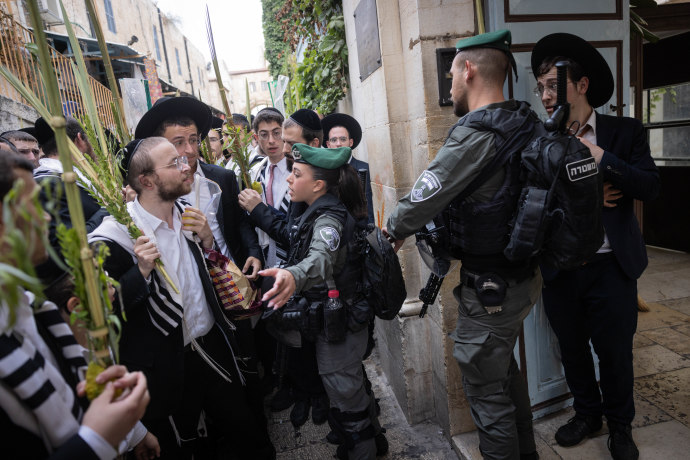What do the ultra-Orthodox parties do when they encounter a brick wall? - Opinion

Have you ever heard of Shifra Asraf from Shas? Or Nava Antabi? Or Deborah Krasniansky from the ‘Eretz HaKodesh’ party? Or Shoshana Dasler? You have probably never heard of these women, but they are politicians from Shas and Eretz HaKodesh (a slate connected to MK Yitzhak Pindrus of Degel HaTorah) at the World Zionist Congress. How did this happen? How is it, that unlike their allied factions in the Knesset, these two ultra-Orthodox parties have women on their lists at the Zionist Congress? It’s simple: these are the rules.
A few years ago, we stipulated in the Zionist Movement’s constitution that every list needs to consist of at least 30% women, and the ultra-Orthodox lists - at first Shas, and then the Ashkenazi list - simply realized there was no getting out of it. So they did what the ultra-Orthodox parties always do when they have no choice: They stated that a sacred principle was already less sacred. They suddenly became flexible. What one day was ‘unthinkable!’ and ‘our Rabbis forbid it!’ suddenly became permissible.
I don’t know how the current debate on ultra-Orthodox military service will be resolved, but what we’ve learned in the national institutions is that when the ultra-Orthodox parties meet a brick wall, they change. In the Knesset, they have the power to threaten potential coalition partners on both the right and the left. But in the Zionist Congress, in order to be part of the governing coalition, they have gone as far as to even sign a coalition agreement with the Conservative and Reform movements.
The World Zionist Congress, the organization that Herzl founded in Basel, remains a distinctly liberal body even today. The ultra-Orthodox who joined it not so long ago have not only not changed it. They’ve actually changed themselves, and they’ve been changed by it. Last week, against the backdrop of the war here in Israel and rising antisemitism around the world, the Zionist General Council - the highest body of the Zionist movement that meets annually between Zionist Congresses - convened in Jerusalem. In preparation for this gathering, the Zionist-liberal bloc in the Congress united, organized, and proposed a series of constitutional amendments designed to strengthen the democratic nature of the Zionist movement and anchor the values expressed in Israel’s Declaration of Independence in the movement’s constitution. The challenge was great. Constitutional changes require a two-thirds majority, a nearly impossible task.
We can now say with great satisfaction that this effort was far more successful than its organizers imagined. A considerable portion of our proposals received the necessary majority, and the constitution was amended. And all of the proposals from the liberal bloc - even those that did not receive the required supermajority - won a solid majority of at least 60%, an important achievement. The Zionist Movement, from Herzl through today, is a liberal one.
One of our most important achievements was the passage of an amendment concerning the fight against discrimination and racism. The amendment reflects Section 7A of Israel’s Basic Law: The Knesset (the so-called “Kahane clause”) but expands it significantly. Its passage means that from now on, a list of candidates will not be able to participate in the elections to the Zionist Congress if, among other things, it engages in incitement to racism or discrimination on the basis of origin, nationality, race, gender, or sexual orientation.
Beyond the obvious ideological and ethical reasons, why does implementing and enforcing rules like this matter? Because just as we saw when the Zionist Movement decided that a party that is not ready to include women on its list cannot run for the Congress, and what do you know? – women have been included by the ultra-Orthodox parties – implementing and firmly upholding clear standards that apply to all can be a formula for change on a wide range of matters in Israel, such as the issue of ultra-Orthodox enlistment. No one wants to push the ultra-Orthodox or any group out of the democratic dialogue and process, heaven forbid. On the contrary. But we’ve seen that when clear rules are simply set and enforced, those who want to maintain their seat at the table suddenly adjust and adapt.
The ultra-Orthodox parties will change their hardline approach on issues when the non-Orthodox majority decides to draw a line in the sand. Extremists will be more likely to moderate when their ability to have any influence on any issue whatsoever depends on it. Here at the national institutions, who would have ever imagined that two ultra-Orthodox parties would put women on their lists and sign a partnership agreement with Reform and Conservative Jews? But they did so because the clear majority stood on clear principle.
One only had to stand on the sidelines of the recent General Council meeting in Jerusalem to see how, after the microphones are turned off, heartfelt personal connections are formed. How partitions come down. How ultra-Orthodox Jews can meet a Conservative or Reform rabbi and suddenly see that the ‘demon’ is actually not such a demon. That pluralism is not a curse. That there is more than one way to be Jewish. Zionism is a liberal movement. That’s how it was created. The movement’s DNA is as democratic as it is Jewish. While the current Knesset has often made it hard to believe, the Zionist Congress is showing us that a different type of politics is possible.
Dr. Yizhar Hess is the Vice Chairman of the WZO
Jerusalem Post Store
`; document.getElementById("linkPremium").innerHTML = cont; var divWithLink = document.getElementById("premium-link"); if (divWithLink !== null && divWithLink !== 'undefined') { divWithLink.style.border = "solid 1px #cb0f3e"; divWithLink.style.textAlign = "center"; divWithLink.style.marginBottom = "15px"; divWithLink.style.marginTop = "15px"; divWithLink.style.width = "100%"; divWithLink.style.backgroundColor = "#122952"; divWithLink.style.color = "#ffffff"; divWithLink.style.lineHeight = "1.5"; } } (function (v, i) { });

